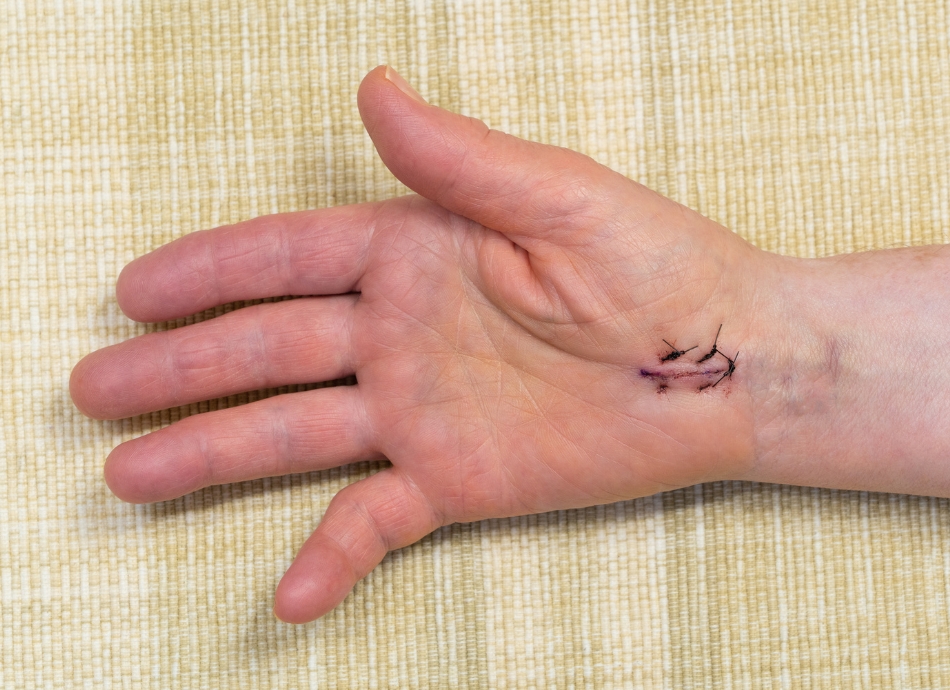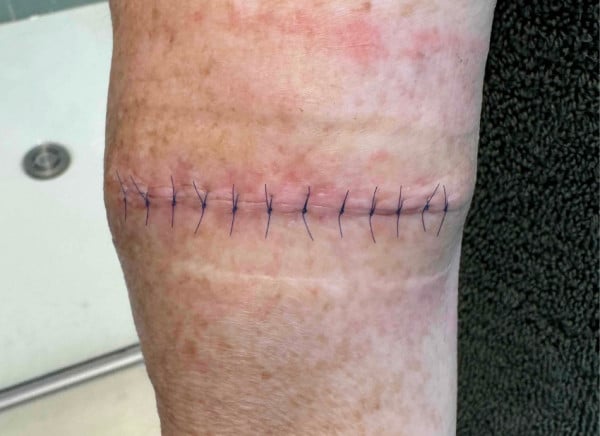Surgical wound care at home
Key points about surgical wounds
- A surgical wound is a cut made in your skin during an operation or surgical procedure.
- Keeping surgical wounds clean and dry reduces the risk of infection and encourages the healing process.

Wounds are closed with stitches (sometimes called sutures), metal clips, staples or glue. What is used depends on the type of surgery, the type of wound and the area of your body.
- Dissolvable stitches usually disappear in about 1 to 3 weeks. Don't pull your stitches.
- Non-dissolvable stitches are usually removed after 3 to 14 days. You will be told when and where they will be removed. Don't pull your stitches.
- Clips and staples are usually removed after 3 to 14 days depending on what surgery you have had. Don't pull your clips or staples.
- Sometimes staples are removed after 3 days and replaced with steri-strips (thin adhesive strips placed across the wound). Steri-strips are usually left in place until they fall off.
- Glue may be used on smaller wounds and doesn't need removing. It usually peels off by itself in 5 to 10 days. You should try to keep the wound dry for about 5 days. Don't pick the glue off.
After the cut is joined back together, the skin edges form an early seal within a few days. This then strengthens over the following weeks and months.
The image below shows a surgical wound held together with non-dissolvable stitches.

Image credit: Healthify He Puna Waiora
Not all surgical wounds need dressings. A dressing may be used to:
- absorb any leakage from the wound
- provide the ideal conditions for healing
- protect the area until the wound is healed
- prevent stitches catching on clothing.
You will be told if your wound needs any further dressings when you leave hospital. Keep your dressing on until you're told it's okay to remove it.
As your wound heals it's normal to experience some of the following:
- stiffness and soreness, which will ease off after a few days
- tingling, numbness or itching
- a slightly hard, lumpy feeling as new tissue forms
- slight pulling around the stitches as the wound heals.
Don't pick off any scabs, as they protect the new tissue under the wound and act as nature's dressing. They will fall off on their own.
My wound is swelling
Some swelling around a wound is normal. If your wound seems very swollen, or the swelling is getting worse or causing problems, contact the surgery or an after-hours service(external link). Elevating the wounded part can help.
My wound is bleeding
If your wound bleeds, press a clean cloth on the area for 15 minutes. Slowly release the pressure to check if the bleeding has stopped. If it keeps bleeding, reapply firm pressure. If it doesn't stop bleeding, contact your healthcare provider or an after-hours service.
My wound is coming apart
Occasionally, your wound may break open. Cover the wound with a clean dressing and contact your healthcare provider. There are many different ways of managing a wound breakdown so please take guidance from your doctor or nurse. You don't need to go to an after-hours service if you can see your own healthcare provider within 24 hours.
My wound is painful
If you have had a local anaesthetic, the effects will wear off after 2 to 4 hours and you may need some pain relief. You can use the tablets that have been prescribed, or you can take paracetamol. Don't take aspirin for pain as it can cause bleeding in some people. However, if you normally take an aspirin a day, don't stop unless advised to by your healthcare provider. Elevating the wounded part can reduce pain and swelling.
A lot of wounds heal without any problems. However, the most common complication after surgery is wound infection. This happens when germs start to grow in the wound.
See your healthcare provider urgently if you have these symptomsContact your healthcare provider if you develop a fever (feeling hot and/or cold and unwell), have any concerns about your wound or if your wound:
Wound infections can be successfully treated if caught early but can cause life or limb-threatening complications if left too long. |
There are a number of things you can do to reduce the risk of your wound getting infected and to promote healing.
Keep the wound dry
Surgical wounds need to be kept dry for 2 days. However, gentle cleaning can be done safely if this is required.
- You'll be told when you can have a bath or shower. Showering is preferable to bathing, as soaking the wounds might cause them to open up. Only take a bath if you're sure you can keep your wounds dry.
- Some dressings are waterproof and can be left in place while you take a shower or bath. Other dressings need to be removed. Your nurse or doctor will tell you which you have.
- Don't put any soap, shower gel, body lotion, powder or other bathing products directly onto your wound.
Change the dressing
The original dressing can be left in place for up to 2 days (or as advised by your nurse or doctor), as long as it is not oozing. The wound must be kept dry for 2 days. If the dressing becomes wet, it must be changed.
When you change a dressing:
- wash your hands with soap and water
- carefully take the used dressing off, while avoiding touching the used side of the dressing
- don't touch the wound with your fingers
- take care not to touch the inside of the new dressing, so that it remains germ-free
- don't apply antiseptic cream under the dressing.
Showering or bathing can begin 12 to 24 hours after your surgery. This is best done between dressing changes. Showering is preferred over bathing and avoid soaking your wound in water. The wound can be gently cleaned, followed by gentling patting it dry with a towel, and then reapplying the new dressing. Face and scalp wounds can be left uncovered.
Other tips for protecting and caring for your surgical wound
- Eat a healthy balanced diet.
- Don’t smoke.
- If the wound is in a limb, elevate it when possible to reduce pain and swelling, and improve healing.
- If you have diabetes, keep your blood glucose levels under good control.
- Don't wear restrictive or tight clothing over your wound.
- Change into fresh clean clothes every day.
- Keep bed linen fresh.
- If you have animals, wash your hands well after touching them. Don't let them sleep on your bed or sit on your lap until your wound is healed.
- For the first few days after the stitches/staples are removed, the wound will be weak, so take extra care to avoid stretching or knocking it.
- Don't do too much activity or dirty work, sport or play until the wound has healed. However gentle regular walking is generally safe and can help with healing. We recommend you follow the advice of your surgeon.
Apps reviewed by Healthify
You may find it useful to look at some Skin care (dermatology) apps.
Gently massage a skin-softening cream (called an emollient) or vitamin cream on the healed area to help keep it soft and supple. A scar can take up to a year for full healing to occur and reach its final appearance and strength. In the first few weeks the scar can be red and swollen. Eventually it loses this colour and flattens out.
The scar is more easily affected by the sun and too much sunlight can cause permanent darkening for up to a year, so use sunscreen regularly and don't use tanning beds.
Looking after your skin surgery wound(external link) HealthInfo NZ
Antibiotics for your skin(external link) Choosing Wisely, NZ
Apps
References
Credits: Healthify editorial team. Healthify is brought to you by Health Navigator Charitable Trust.
Reviewed by: Claire Todd, Community Wound CNS, Wellington
Last reviewed:





